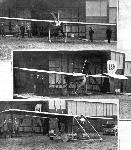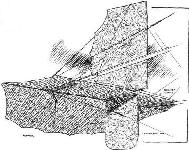P.Lewis British Aircraft 1809-1914 (Putnam)
Mersey Military Trials Monoplane
The design of the Mersey Military Trials Monoplane originated with Planes Ltd., of Freshfield, Liverpool, and was developed after May, 1912, by the Mersey Aeroplane Co., of R. C. Fenwick and S. T. Swaby, for the Military Trials held on Salisbury Plain during the following August. In its original form, with a smaller rudder and no vertical surface below the elevator, it flew at Freshfield for the first time late in 1911. Designed and flown by Fenwick, the machine was somewhat of a freak. The seven-cylinder 45 h.p. Isaacson radial engine was mounted in the nose, and the propeller was fitted behind the wings, being driven by an extension shaft which passed between the seats of the two side-by-side passengers. 2 : 1 reduction gearing was employed, and the tail unit was supported by a pair of steel-tubing booms, an arrangement which proved to be very weak and unstable longitudinally. As No. 19. the machine crashed at the Trials on 13th August, 1912, with fatal results to Fenwick. Span, 35 ft. Length, 24 ft. Wing area, 220 sq. ft. Weight empty, 750 lb. Weight loaded, 1,150 lb. Maximum speed, 55 m.p.h. Endurance, 6 hrs.
Показать полностью
M.Goodall, A.Tagg British Aircraft before the Great War (Schiffer)
Deleted by request of (c)Schiffer Publishing
MERSEY monoplane (Mersey Aeroplane Co., Freshfield, Liverpool, Lancashire)
R.C. Fenwick and ST. Swaby began the design and construction of this machine when managers of Planes Ltd., and completed the aircraft at their premises. The aircraft flew for the first time late in 1911 with Fenwick, the designer, as pilot. The partners took over the development of the machine to prepare for entry in the Military Trials of August 1912, in the course of which it crashed, killing Fenwick.
The machine was a side-by-side two-seater with a nacelle between the wings, which were attached at the top longerons. The engine in the front drove a pusher propeller at half speed though an extension shaft, passing between the two seats. Steel tubing was used for the booms, wing spars and undercarriage structure. The wings were braced by wires to tall king posts and to the undercarriage, including to the wheel centers. The tail unit was carried on the pair of horizontal tubes, which, with single wire bracing, appeared quite inadequate.
The tail surfaces consisted of a single tailplane and elevator with balanced rudder above and a small fixed fin below, although originally a smaller rudder and no fin were fitted.
Power: 45hp Isaacson seven-cylinder radial air-cooled driving a pusher propeller by a 2 to 1 reduction gearing and shaft.
Data
Span 35ft
Chord 7ft
Area 220 sq ft
Weight 750 lb
Weight allup 1,150lb
Speed 55mph
Показать полностью
Журнал Flight
Flight, July 13, 1912.
AIR EDDIES.
That entered by the Mersey Aeroplane Co. is a monoplane of particularly clever design. Pilot and passenger sit side by side in a racy little body which has a 45-h.p. Isaacson motor clamped to the front and the propeller, shaft driven, at the rear. The wing span is 35 ft. and overall length 24 ft.
Flight, August 17, 1912.
THE MERSEY MONOPLANE.
THIS extremely interesting monoplane, which, unhappily, was wrecked at Salisbury Plain on Tuesday evening last and which was contributory to the sad death of its designer and constructor, Mr. R. C. Fenwick, was purely an experimental machine, and had passed through a variety of modifications. The keystone of the design was that the propeller had been arranged behind the pilot and passenger while the engine had been retained in front. In this manner it rendered the machine particularly applicable to military use, for the absence of the propeller in front made observation much more easy and rendered possible the use of a gun pointing forwards. In our opinion it embodied the germ of an idea that was well worthy the time spent to evolve it, but in some ways we considered the constructive details to be a little of the makeshift order, especially as regards the tail trussing. This was a point that we had discussed with Mr. Fenwick a few days previously. He told us that he had tested the strength of that section of the machine, by hanging a man to the extreme end of the tail and lifting him clear of the ground.by the manipulation of the elevator in the slip stream from the propeller. It had withstood that test perfectly, but he was not entirely satisfied and meant to modify it in his next machine. This, however, by the way, for the direct cause of the accident has not yet been definitely established.
The central section of the design was a bluff streamline body 7 ft. in length, in which the pilot and passenger sat side by side. Between them ran the propeller-shaft that connected the motor, a 45-h.p. Isaacson, bolted to the front of the body, to the propeller at the rear. The propeller revolved at half engine speed. The chord dimension of the wings was also 7 ft., and they proceeded outwards from each side of the body without any dihedral angle, spanning 35 feet. Steel spars were used in their construction, and they were braced in the usual manner to the cabane above and the skids below. The body lay wholly below the wings - although the pilot looked out over the top of them - in order to bring the centre of thrust of the propeller on the line of the centre of resistance. The under-carriage, as will be seen from the sketch, was of the wheel and skid type, and the skids continued far in front of the machine to obviate any chance of the machine, when landing on bad ground, turning on to its nose. The landing gear was exceptionally high. This undoubtedly lowered considerably the centre of resistance and was expected to do so by the designer. The tail, with its elevator and rudder, were carried by an outrigger consisting of two tubular steel booms stayed by single piano wires top and bottom to the overhead mast and the undercarriage. On the previous Sunday evening it had flown very satisfactorily, and under none too pleasant conditions. It has carried, in addition to its pilot (Mr. Fenwick) and its passenger (Mr. H. Petre), a load of fuel sufficient to keep it in the air for six hours. It rose and flew exceptionally well with all that weight, considering it was equipped with such a relatively low-powered motor as the 45-h.p. Isaacson.
FATAL ACCIDENT TO MR. R. C. FENWICK.
IT is a matter of supreme regret when any aviator should lose his life in the cause, but it is especially to be deplored that the military aeroplane trials should thus have been marred by a fatal accident. Mr. R. C. Fenwick, designer, constructor and pilot of the Mersey monoplane, took his machine out for the third time on Tuesday evening, about a quarter past six, and flew off in the direction of Stonehenge. About a mile and a half from the sheds the machine was noticed to fly unsteadily, and the end of this unhappy effort was, by all accounts, a nose dive to earth at the termination of which Mr. Fenwick was killed and the aeroplane wrecked.
Few people, apparently, saw, or were in a position to see exactly, what happened, but from observations it was noted that the anemometer registered a sudden increase in gustiness about the time the machine started off on its last journey, while Busteed, who was flying the Bristol monoplane in that vicinity just previously, is similarly reported to have stated that the remous thereabouts were very bad. The why and wherefore of the accident, however, it is the proper purpose of the Public Safety and Accidents Investigation Committee of the Royal Aero Club to investigate, the debris having been thoroughly inspected by responsible persons before it was destroyed by fire. It is, however, to be hoped in this connection that in all cases of disasters of this character, discretion will be used as to the time when the wreckage may be turned into a bonfire, seeing that when a pilot loses his life the least that those living can do in his honour is to profit in all reverence by the lessons of his misfortune.
In all the principal aviation centres, representatives of the safety committee have been appointed by the Royal Aero Club and it is to be hoped that the military authorities, police and aerodrome managers will assist them in efficiently carrying out their work, and will at any rate, as we have suggested, avoid any wanton destruction of invaluable evidence for the sake of hypocritical sentiment.
The aviation world suffers a great loss by Mr. Fenwick's death; he was a clever designer and an able pilot, which combination is none so common that we can afford to lose even one of any we have. The Mersey aeroplane on which the fatal accident occurred was No. 19 in the trials and had made only two previous ascents.
Показать полностью







